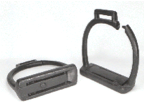CONFEDERATE SADDLE STIRRUPS AND OTHER COMMON WAR TIME PATTERNS
By Ken R Knopp
I wrote this article sometime about 2005. This article ran in the North South Trader (I cant remember when?) as well as Camp Chase Gazette. I have learned a lot more and accumulated many more photos since it was wrote. I need to expand upon it or….write another book!
The subject of wartime brass and iron stirrups have long been a topic of conversation and speculation among relic hunters, collectors and historians. A lack of solid documentation and the endless varieties of stirrups both excavated and found on relic saddles have often fueled debates about what patterns can be considered of Confederate manufacture or use. Even among official Federal patterns which are generally clear, information is meager and variances frustratingly numerous. However, those made or issued by the Confederacy unfortunately leave a lot more to speculation.At the outset of the war, the use of bent wood stirrups on military saddles was a relatively new innovation that differed greatly from the dominant European influences then guiding the manufacture of United States Army military equipage. American-made saddles from the Revolution through the Dragoon period, including a lot of civilian saddlery used widely varying patterns of iron and brass stirrups, most with strong European characteristics.
  |
|
| Early American stirrup. The swivel pattern strap loop was common with stirrups in the Colonial period. | |
  |
|
| Typical Federal 1859 McClellan “tear-drop” pattern bent wood stirrup missing its leather hood. |
Then in the mid-1850s, the U.S. Army began experimenting with a new bent wood stirrup on its trial Campbell and Hope military saddles. Though new to the military, their historical use on saddlery was not entirely revolutionary as stirrups of bent or carved wood had likely been in use for centuries. Surviving ancient specimens reveal beautiful, ornately carved stirrups, most with Spanish or Mexican origins, however the use of a simple flat split of tough oak or hickory wood, steamed then bent into the military “tear-drop” shape appears to be largely an American design. When the war began, the Federal government worked feverishly to provide its cavalry the M1859 McClellen saddle equipments which used a wooden stirrup of hickory or oak “made of one piece bent, the ends separated by 1 transom and fastened by 2 iron rivets…..(covered with) leather hoods, (of) thick harness-leather.”
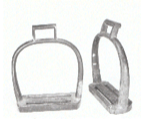  |
|
| M1833 Dragoon pattern U.S. artillery stirrup. Solid brass with “shafted” or cutout treads. Variations include stirrups with solid treads. The pre-war brass Dragoon stirrup may have differed from artillery issue in the width of the stirrup strap loop; 1.35 inches wide for cavalry and 1.5 inches wide for artillery. Slightly different variations of the artillery pattern were made and used in the U.S. Army until the turn of the century. |
Though cast iron expedients for both Federal cavalry and artillery are believed to have been temporarily utilized by the War Department in the chaos of the early days, their artillery “officially” retained the M1833 Dragoon pattern brass stirrup common to its pre-war artillery equipments. For the South, a similar though delayed scenario took place. It must be remembered that at the beginning of the war the individual Southerner largely supplied his own saddlery. It is likely then that the civilian soldier coming into Confederate cavalry and to some extent artillery service, brought with him all manner of wood, cast iron or brass stirrups in all of the attractive and popular civilian configurations of the day.
 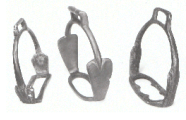 |
|
| Early pre-war pattern cast iron and brass stirrups(Colonial to 1860). Literally dozens of widely varying patterns, many with European origins or influences have been excavated from war-time sites. |
Or, as with bridle bits, copies of fashionable military patterns. Their wide varieties are evidenced by the multitudes of otherwise unidentifiable metal stirrups that are excavated from war time sites. Early war purchases by the Ordnance Department from Southern saddleries and harness shops garnered more non-uniform stirrup configurations until bureau manufacture stabilized saddle production in early 1862. An absence of surviving data makes it nearly impossible to determine the type stirrups the Confederacy supplied with their artillery saddles. Nevertheless, lacking conclusive documentation, it is reasonable to assume that the experienced Ordnance Officers from the old army copied Federal Ordnance guidelines by adopting or at least trying to manufacture some kind of brass or iron stirrups. However, except for purchases from existing pre-war stores, no mention of “casting” iron or brass stirrups can be found in the surviving Ordnance Department records. Still, there was clearly some capacity for this. Southern foundries and mills could have easily cast some, or at least provided bar iron to the ordnance facilities for hand-forged stirrup production, as they did for bridle bits, buckles and rings, etc. In fact, modern relic archeologists report some consistency in cast stirrups dug from war-time sites yet, these excavated variants could just as easily be popular Antebellum archetypes, imports or Confederate duplications of any of them.
  |
  |
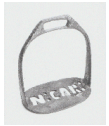  |
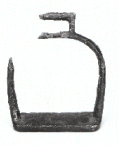  |
||||||
| L: This stirrup pattern made of iron may well be French Hussars in origins. R: A common Ante-bellum cast iron stirrup. Stirrups of this pattern have been retrieved from the wreck of the “Arabia” steamboat sunk in the Missouri River in 1856. | “Star” stirrups. Possibly denoting Texas or Mississippi or simply a popular period pattern these were cast in some quantity and in at least two variations, though their origins are wholly unknown. | North Carolina Stirrup. “Cut-out” stirrups such as these have been found for most Southern states and even a few Northern states. | Rare Japanned iron variation of the M1841 Dragoon pattern artillery stirrup. This rare stirrup was purposely destroyed or damaged in battle before being recovered from the Fort Defiance Confederate position at Port Hudson, La. |
|
|
|
|
||
| Abraham Pawling Safety “Spring” (breakaway) Stirrups patented in June 1846. These stirrups were designed to release the riders foot in an emergency and prevent him from being dragged to death. | Another period spring stirrup differs in the way the shank (bows) hinges to the tread. A third, possibly English pattern combines the shank locking method from Figure # 9 and the tread hinge of Figure 10. | Variations of hand forged bar iron stirrups. These crude but simple patterns were easily made by blacksmiths and date back to the 18th century and earlier. Often excavated in eastern and western CW sites they may be cheap Southern replacements when other (wood) stirrups were not available. |
Fortunately, for trooper’s cavalry saddles the record is a little more clear. The Confederates like their Union counterparts, unmistakably adopted the now popular and inexpensive wooden stirrup covered with a leather hood. Though some forgiving and substitution was most certainly allowed, surviving correspondence indicates that throughout the war Southern arsenals and their contractors tried very hard to adhere as much as possible to this standard by providing a pair of wooden stirrups with each Jenifer, McClellen or Texas saddle. Only a limited amount of information about a handful of stirrup manufacturers could be found in the surviving record of both eastern and western arsenals. Sadly, deliveries are usually noted only as “stirrups”. However, since many of these firms also made saddle trees, one might reasonably conclude that most of their stirrups were made of wood as well. In the east, great quantities of wooden stirrups appear to have been made at the Richmond Depot or at the Central Harness Shops in Clarksville Va., many for their own saddle production or for furnishing to the large number of saddle manufacturers which were contracted in early 1863. Still, it appears that throughout the South wood stirrups, or more specifically the contractors and materials necessary for providing a sufficient quantity, were sometimes in short supply. Even at Clarksville which was comparatively better supplied than most horse equipment producing arsenals, the proper allocation of wood and skilled labor were often an impediment to maintaining a consistent stock of saddles- particularly late in the war.
 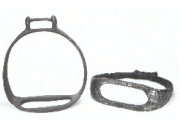 |
| This cast iron stirrup may well be a Confederate issue (possibly artillery) stirrup. They are excavated from Confederate sites in significant quantities particularly in the east. Bannerman’s 1927 Militaria Catalog indicates they were Confederate cavalry stirrups brought into the South from Europe on Blockade runners, however their origins remain unclear. |
To continue production, some arsenals and contractors were apparently forced to turn to cheap expedients made of light-weight iron. In fact, a significant number of rather simple, often crude, hand-forged iron bar stock stirrups, believed to be of Confederate manufacture, have been excavated from war-sites and show an impoverished design reminiscent of earlier periods. In addition, some effort was probably made to supply stirrups by purchasing them from overseas sources but again surviving documentation is tragically vague. The record book of goods arriving at the Bureau’s main port of entry at Wilmington NC shows large numbers of barrels, casks and cases of “cavalry equipments” or “saddlery” but beyond those certain to have accompanied imported British saddles, no specific mention is made concerning stirrups of any kind.
  |
  |
|
| Variations of British a\Army’s “Hussars” stirrups which accompanied both the early 1850’s Hussars Pattern and the 1856 Universal Pattern Saddles imported by the Confederacy and used by the British for decades after. | Classic but simple cast iron stirrups such as these are a very common 19th Century pattern. They are post war (1880’s and later) stirrups made for Kentucky Spring Seat saddles, Somerset and common catalog saddles. Two different tread widths (sizes) are found some with fancy scroll work on the treads tops. |
CONFEDERATE WOOD STIRRUPS: The standard wooden stirrup used on Confederate cavalry saddles was copied from Federal specifications. At Southern arsenals it was generally made from a single piece of hickory or oak wood with a three inch tread and bent into a tear drop shape, the ends connected by a wood “transom” pierced by either one or two iron rivets and usually covered (hooded) with russet skirting leather. In February 1864, a relentless and pervasive shortage of leather created the need for cosmetic change to Confederate manufactured stirrups. A circular issued to all arsenals by the Ordnance Department ordered that the use of leather hoods on wood stirrups be thereafter discontinued.
  |
| This un-military appearing “U” shaped bent wood stirrup is a late 19th century “Santiago” or “Dallas” pattern. It was simple to make and a common civilian or catalog pattern after the war but NEVER a Confederate pattern. In fact, most variations of wood stirrups are post war makes. By the turn of the century there were at least sixteen different notable patterns of wood stirrups. |
  |
| Confederate version of the Federal “tear-drop” bent wood stirrup. Rounded top stirrups like this are found on a number but not all, documented Confederate saddles. Some variations have a very high neck. |
It is of interest to note that a significant number of wood stirrups found on surviving C. S. saddles differ from the most common issue Federal McClellan stirrup by having the top ends of the wood shanks (bows) rounded instead of squared off. But it is not clear if this was intentional policy or simply a common contractor variation. Other wood stirrups with many subtleties were steamed and bent into simple but variable “U” shapes during the later part of the 19th century. These less sophisticated though entirely serviceable stirrups are simple to make and common even today. However there is no documentation that they were made by the South or even common war time patterns. In addition, a multitude of metal stirrup patterns are excavated in war time sites or found with relic saddles- always undeniably subject to easy transfer at any time since the war. Given these facts the true origins and conclusive use of many 19th century metal specimens including those of Southern war-time manufacture, are probably lost to history.
CONCLUSION: In summary, while the history of the tear-drop wood stirrup issued with military saddles on both sides of the conflict is fairly plain an unfortunate lack of documentation leaves the definitive understanding of both 19th Century metal and wood stirrup patterns obscure indeed.
 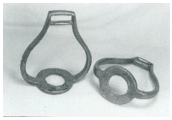 |
 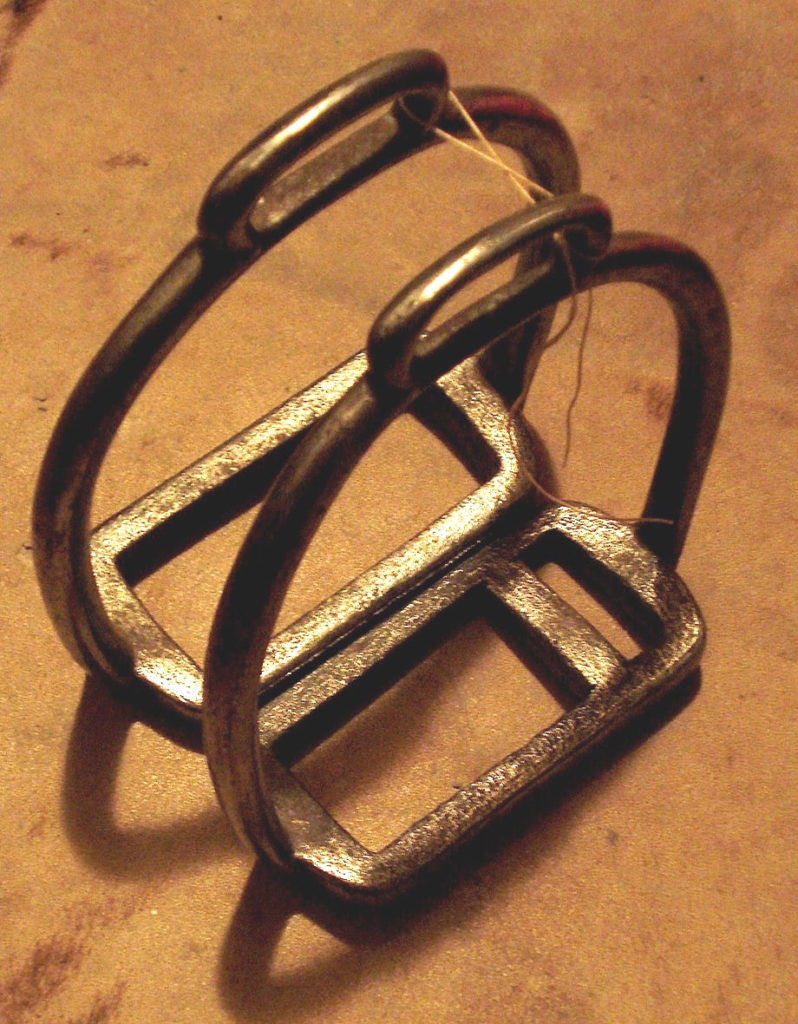 |
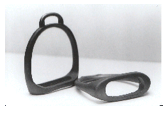  |
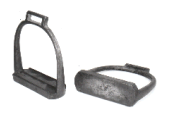  |
||||
| Brass stirrups identical to these are found on an early 19th century French Hussar’s saddle in the Museum of Paris. | The M1824 French military stirrups. | Variation of French Artillery pattern. A common aspect of many French military stirrups are their rounded strap slots and long-oval or rectangular “boxed” treads. | M1904 Artillery (brass) Stirrup. Similar to earlier military patterns however, these are noted for their solid tread and the “US” stamp on the underside. |
SOURCES:
Account Book of Capt. John M. Payne, comprising imported ordnance stores at Wilmington, NC., the Ordnance Bureau’s main port of entry, 1863-1865. Eleanor S. Brockenbrough Library, Museum of the Confederacy, Richmond, Va.
The Ordnance Manual for The use of Officers of the Confederate States Army, First Edition, Richmond, Va. 1863, Pg. 150 and Plate 2. In the beginning, the Confederate Ordnance Department inconsistently utilized portions of the earlier Federal ordnance regulations of 1841 and 1850 and, other General Orders. In 1862 they published their “Field Manual for Use of Officers on Ordnance Duty, Prepared by the Ordnance Bureau.” Printed by Ritchie & Dunnavent, Richmond. In early 1863 they published and distributed to ordnance facilities their own adaption of the Federal manual of 1861.
ORDNANCE MANUAL FOR USE OF OFFICERS OF THE UNITED STATES, 3rd Edition, 1861, Pg. 155- 167. Detailed descriptions of the new McClellen saddle and horse equipment. Orders No. 13, War Dept. Adj. Gen. Office, Washington, August 15, 1855, Pg. 34-35.
Abstract of Contracts and Correspondence from Ordnance Department arsenal records. Several dozen volumes: Vols. 8,9,10,11,12,16,19,78,100,104,105 for the Nashville and Atlanta Arsenals; Vols. 33,34,36, Augusta Arsenal; Vols. 32,101,3,4,6,7,36, 58,59 1/2,83 Macon Arsenal; Vols. 90,91,91 _, 92,93,94,96,97 Richmond Arsenal/Clarksville Depot. Vols. 140, Savannah Arsenal and others, War Dept. Circular, Feb. 17, 1864, Miscellaneous records of the Ordnance Bureau, Entry 39, Records of the Ordnance Bureau, National Archives.
Confederate Papers Relating to Citizens or Business Firms, Chapt. IV; Record Group 109; National Archives, Washington DC. Firms or individuals having business with the Confederacy. Accessed by last name in alphabetical order and available on microfilm (M346). Files of several hundred firms having contracts or business with the Ordnance Department for the manufacture of horse equipments during the war including some dozen or so stirrup makers. Major Confederate manufacturers of stirrups. Many of these also made saddle trees or other horse equipments: For the Clarksville Depot: M. Nichols and James Nichols, William Farmer; For the Richmond Depot: Thiem & Frapes; for Macon Arsenal: Littlefield & Green, William A. Thomas; for Atlanta Arsenal: William Miller, William Morton and S. Durand; For the Selma Arsenal: N. Smith & Co. Military Service Records, Capt. Henry Pride (Tape # 203); Capt. James Dinwiddie (#76), Major William S. Downer (#78), National Archives War Dept. Collection of Confederate Records.
SADDLES, by Russel M. Beattie, University of Okla Press. Norman Okla. 1981, Pg. 26-31, 47 and 153. MAN MADE MOBILE, EARLY SADDLES OF WESTERN NORTH AMERICA, By Richard E. Ahlborn, Smithsonian Institution Press, Washington D.C. 1980. Pg. 42.
CONFEDERATE BLOCKADE RUNNING THROUGH BERMUDA, 1861-1865, LETTERS AND CARGO MANIFESTS. By Frank E. Vandiver, Univ. Of Texas Press, Austin, 1947.
